NIUE Small Vaka, Big Fish
■ By Herb Spannagl
Unlike most other Pacific islands, Niue rises from the deep blue sea like a calcified mushroom with a green jungle topping. It has just a few delightful small coral beaches and a narrow band of reefs.
The fortress-like coastal cliffs are undercut by high wave action creating a labyrinth of caves and flooded canyons. There are only a few clefts that allowed the construction of boat ramps and steep stairways to give access to the sea. Niue is located within the easterly trade wind belt with most of the development on the sheltered lee side of the island.
This formidable citadel must have been a real challenge to early Polynesian settlers and still constrains tourism today. It has forced tourism entrepreneurs to take stock of and promote Niue’s unique features, such as the prolonged presence of Pacific Humpback whales. They mate, give birth, and nurse their young in the island’s warm and sheltered whale sanctuary.
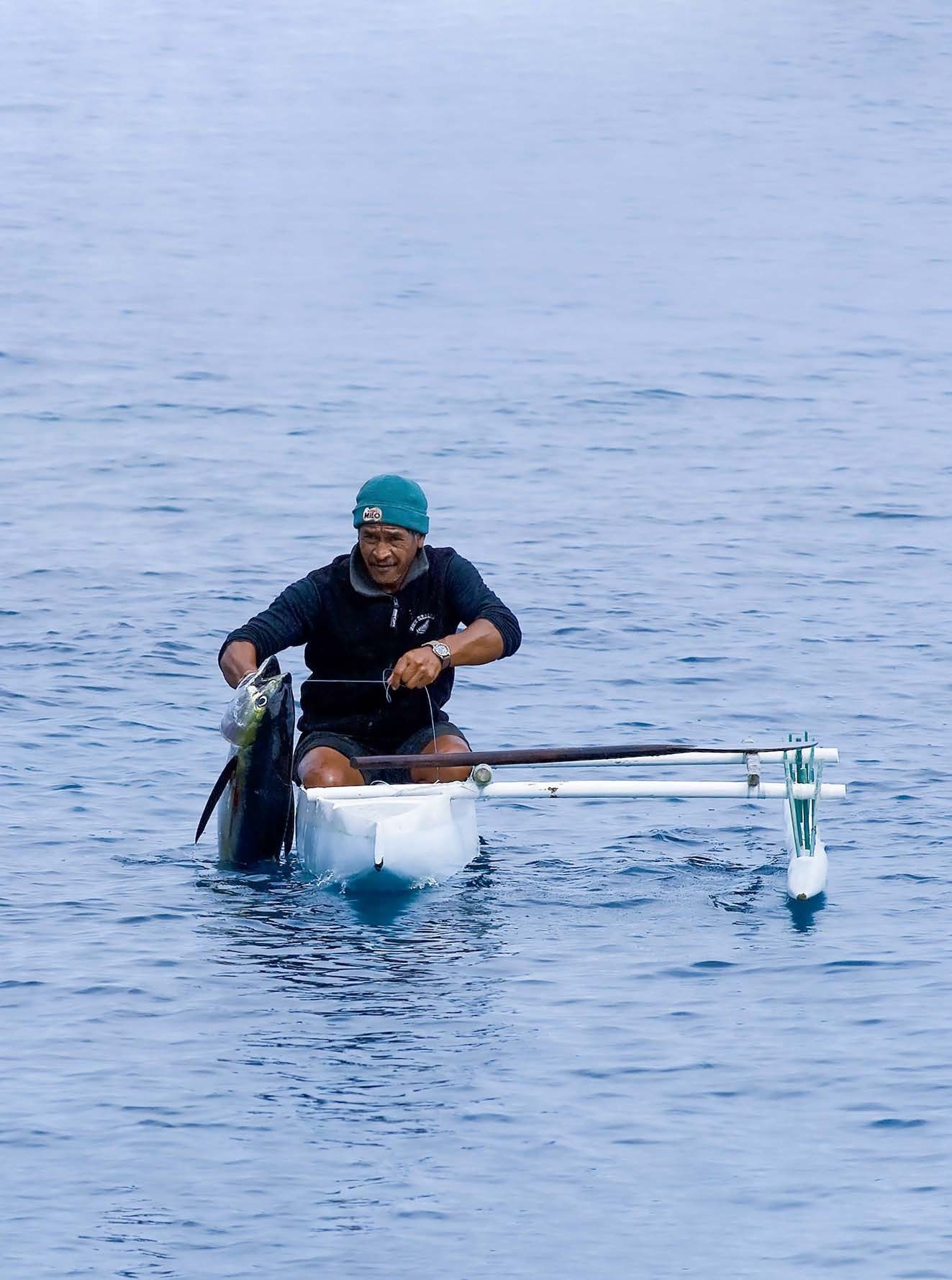
Although their craft (vaka) are only small, Niuean fishermen make some mighty catches including tuna and billfish, all on mono handlines.
Photo: Jeff Evans.
The imposing coastal features are equally impressive below the surface with an abundance of coral gardens teeming with tropical fish. Almost everywhere the reef fringe plunges steeply into the abyss of the Pacific bringing pelagic game fish like marlin, tuna, and wahoo to within a stone’s throw of the shore.
Although I have visited several Pacific islands, I knew little about Niue nor why my wife Sue had booked a holiday there. After my numerous winter fishing trips to the Tongariro, I resigned myself that it was now her turn to choose. Aided by a very helpful lady from Helloworld, a package was arranged that comprised flights, accommodation, and a rental car. I also learned that my wife had booked a fishing and a whale swimming trip.
Our flight went smoothly and after settling into a comfortable bungalow at Taloa Heights we drove along the dense jungle-fringed coastal road past ancestral graves and simple homes. We stopped at several signposted tracks leading steeply down well-constructed steps to look out at spectacular features that giant waves had pounded out of the limestone cliffs. At one stop overlooking the sea, a massive whale surfaced right in front of us. Such chance encounters happened most days.
On day two we went fishing with BJ Rex from Fish Niue Charters. I was impressed with the high-quality boat and fishing gear as well as BJ’s expertise, enthusiasm, and respect for the environment. After visiting several FADs, I landed a 18kg yellowfin tuna. BJ not only does gamefishing trips – he and his wife Vanessa do “swimming with whales” excursions, run a restaurant, manage accommodation, and operate a school bus. They are true entrepreneurs who work their butts off on an island with few employment options.
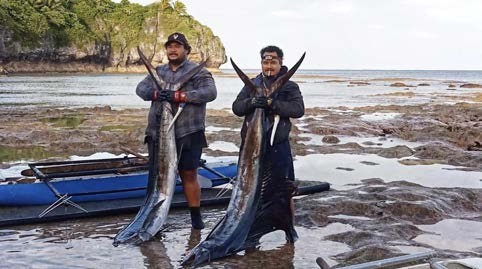
Vaka fisherman with the morning’s catch – two sailfish.
Photo: Narita Viliamu.
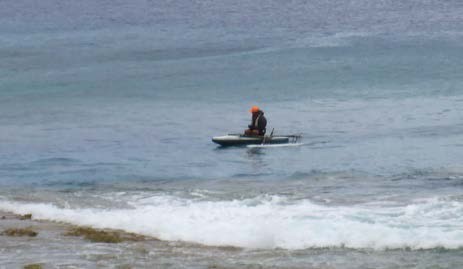
A vaka fisherman waits for the right wave to paddle in on.
1) The traditional vaka is made from a single piece of timber and must be light enough to be carried by the single paddler.
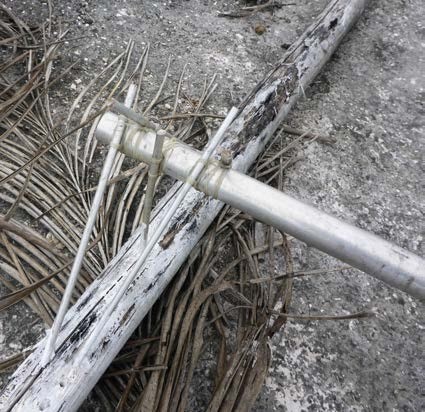
2

3
2 & 3) The vaka are bound together using monofilament line.
Two days later we went out with them on a whale trip. The whale watch business is strictly controlled so as not to disrupt the visiting whales’ wellbeing. Shortly after the boat had been lowered onto the water by a derrick, we spotted a mother and calf not far from the reef. Not wanting to disturb the pair we followed two sub-adult whales that dived when we got close. BJ eased in nearby while Vanessa slipped into the sea looking down with her mask and snorkel. When she raised her arm, everybody rolled overboard and formed a circle peering into the depth. The guides can tell by the angle of the dive what the whales are up to. A steep dive means the whales just sink towards the bottom where they chill out until they need to come up for a breath. This happened twice giving the snorkellers more than 40 minutes of watching the huge beasts only meters below them. My wife was ecstatic.
On many of our trips down the staircases, I saw small, single-seat outrigger dugouts (locally called vaka) resting on rocky platforms and ledges well above the sea. When I tapped one of the painted hulls with my knuckle it sounded hollow. Not looking closer I concluded that this was just a fibreglass job and I basically lost interest. It was quite a shock when I learned that these were vessels completely carved from logs of mahogany wood. Not just a rough dugout but a finely crafted vessel with a hull wall thickness of barely 10mm. It was a brilliant design totally dictated by the difficult terrain that demanded the whole vaka, including the outrigger, be carried by one person down steep and twisting tracks.
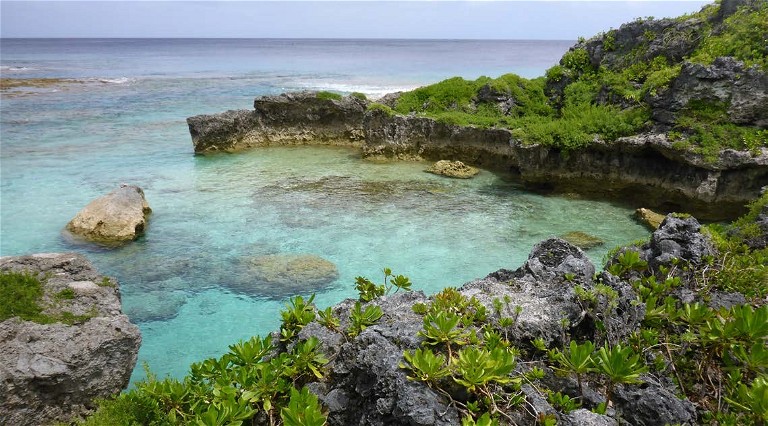
There are lots of coastal nooks and crannies that are interesting to explore with mask and snorkel.
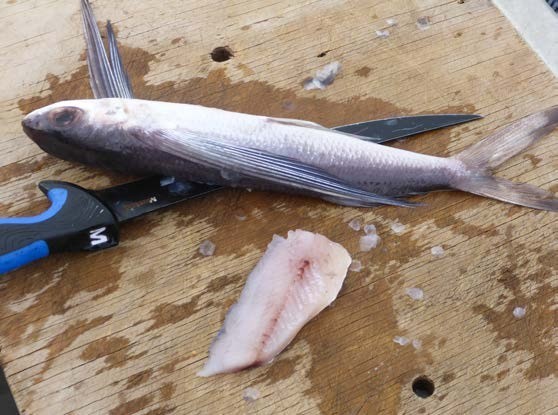
4) Flying fish is a favoured bait for a number of species.
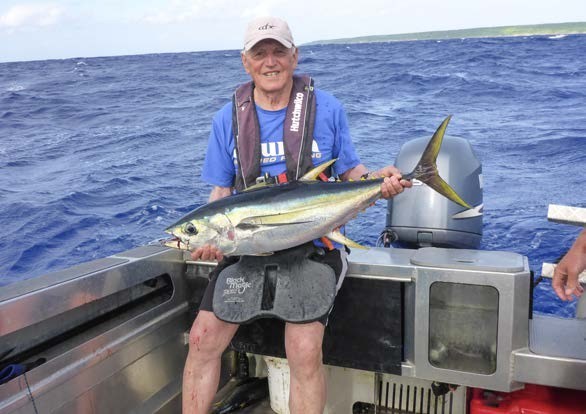
5) Herb with his yellowfin tuna.
Being a kayak fisher with a background in fishing kayak design my interest got an immediate jolt. I had to find out more but where would I start? I asked BJ, who referred me to a young lady in the information centre who kindly took me to a nearby building and introduced me to Carmen whose husband Taumafai Fuhiniu was Niue’s internationally known master vaka builder. He has revived this fine art of traditional vaka building to help his people harvest fish from the surrounding sea. She arranged for us to visit them the next day. ‘Fai, as everybody calls him, was just repairing a vaka, which allowed me to look closely at the hull and ask about the wood, the tools, and the purpose of each part of a vaka.
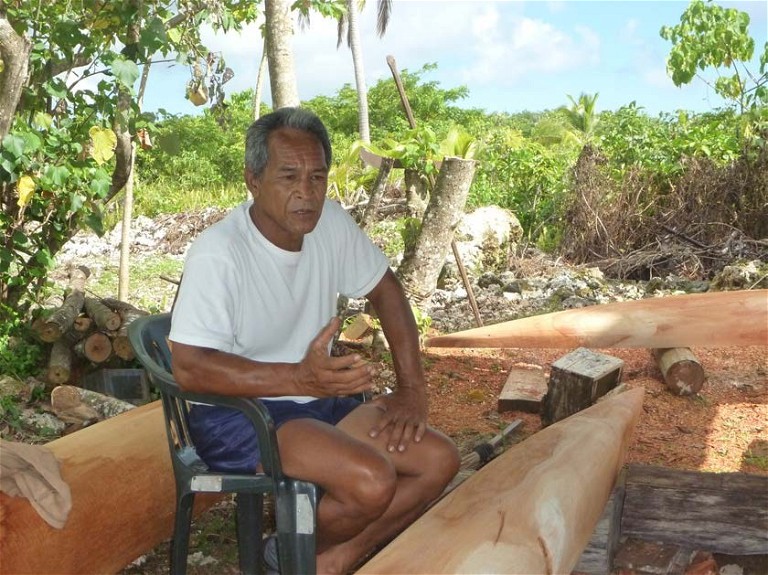
Taumafai Fuhiniu revived Niue’s vaka building culture.
Photo: Sam Mossman.
The wood is mahogany that grows in the rainforest interior of the island. It has interlocking fibres that resist splitting and this allows the hull wall to be adzed down to the thickness of my little finger. Whilst in past times they used sharpened shells for the work ‘Fai now uses a small hand adze. He demonstrated that when the adze no longer bites and the wood bulges out, the required thinness has been achieved. The vaka has wooden fore and aft deck covers of lighter wood.
These decks were traditionally joined to the hull with vines, but today both parts are sewn together with thick fishing monofilament. A simple seating board sits loosely on inside ledges. Vakas are about 4m long and have a solid wood outrigger of the same length. The two are connected by slim hardwood bridges and an intricate array of rods all fastened together with thick fishing mono to keep everything flexible. I never saw a nail, screw, or bolt. The total weight is about 30kg, which is light enough to be carried by a fisher down steep, uneven tracks. By comparison, my own plastic fishing kayak stripped down weighs about 35kg.
Unfortunately, I did not get a chance to see vaka fishers in action but have learned that they fish mainly with handlines and maintain their position with a paddle while berleying with bits of flying fish to attract huge gamefish. Once hooked they fight them on 200lb mono handlines and bring them ashore on these fragile vaka through breaking surf and narrow reef channels. The mind boggles!
Luckily, while we were there the islanders held a fishing competition; one for boats and one for vaka. I visited the weigh-in centre but got there a bit late and missed most entries. The lovely ladies who were apportioning the prize money showed me some impressive photos of vaka-caught fish. The overall winner of the vaka section had landed two marlin – one 80kg and a smaller one. Just thinking about such a feat makes my tuna catch from a gamefishing boat pale into insignificance.
A few days isn’t long enough to unravel the finer details of Niue’s vaka building and fishing culture. I would have loved to fish from a vaka but these are strictly personal craft and are not for hire. More realistically at age 87 and handicapped by two artificial knees, had I hooked a big gamefish on a handline from a strange vessel in an unfamiliar environment I surely would have bitten off more than I could have possibly chewed. Time to stop dreaming.